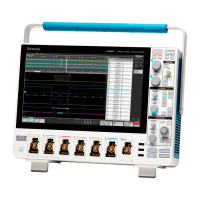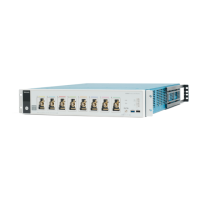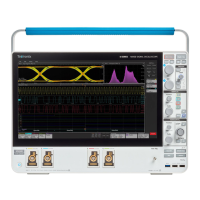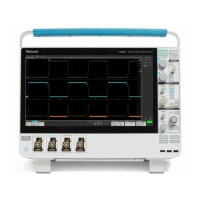Acquisition mode
Envelope mode finds the highest and lowest record points over
many acquisitions. Envelope uses Peak Detect for each individual
acquisition.
Average mode calculates the average value for each record point
over many acquisitions. A
verage uses Sample mode for each
individual acquisition. Use Average mode to reduce random noise.
Roll Mode scrolls sequential waveform points across the display in a right-to-left rolling motion. Roll Mode starts automatically when the
timebase is set to
≥40 ms/div. Roll Mode works at sample rates up to 25 MS/s.
Waveform sample interpolation
When the sample density falls to less than one sample per display column, the instrument must calculate intermediate points to display a
waveform. This process is called interpolation.
There are three options for interpolation:
•
Sin(x)/x interpolation. Computes record points using a curve fit between the actual values acquired. It assumes that all the interpolated
points fall along that curve.
• Linear interpolation. Computes record points between actual acquired samples by using a straight line fit. It assumes that all the
interpolated points fall in their appropriate point in time on that straight line.
• Auto interpolation. Select the best interpolation method.
Coupling
Coupling determines whether an input signal is directly connected to the input channel (DC coupling), connected through a DC blocking
capacitor (AC coupling), or not connected at all (GND coupling).
All probes expect a specific coupling and input termination. Both coupling and input termination are displayed on the screen.
Scaling and positioning
The scaling and positioning controls determine the portion of the input signal received by the acquisition system. Set the vertical scaling,
positioning, and DC offsets to display the features of interest on your waveform and to avoid clipping.
Each waveform Graticule contains ten major divisions. This represents the maximum digitizing range of the instrument for any given
vertical scale. Vertical waveform data that is outside (above and/or below) of the waveform Graticule is clipped; that is, the data values
exceed the digitizing capability of the ADC at the current settings. This causes inaccuracies in amplitude-related measurements. For more
information see Vertical acquisition considerations on page 236.
Waveform acquisition
2 Series MSO MSO24 and MSO22 235
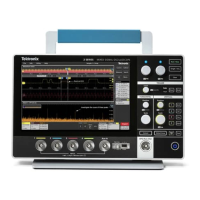
